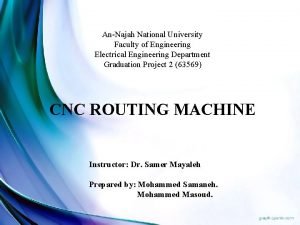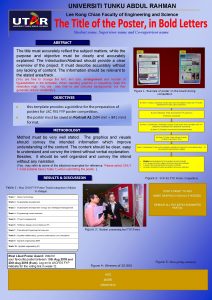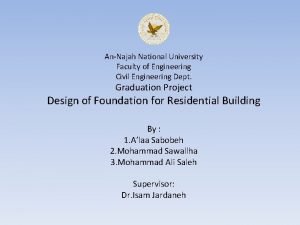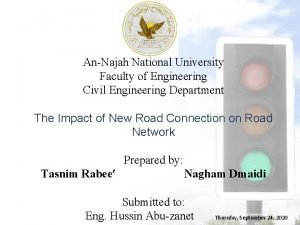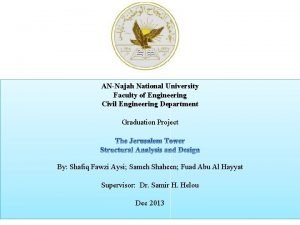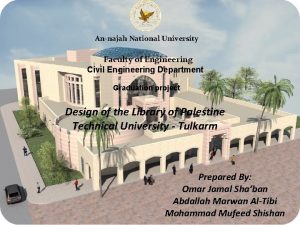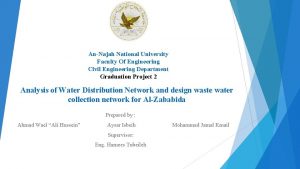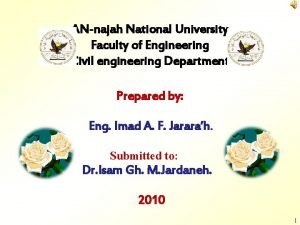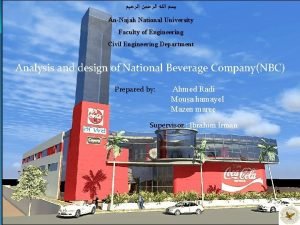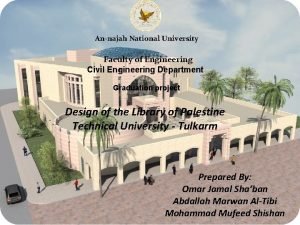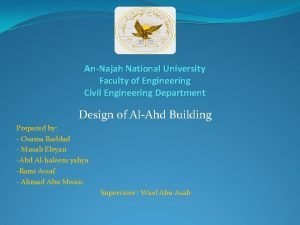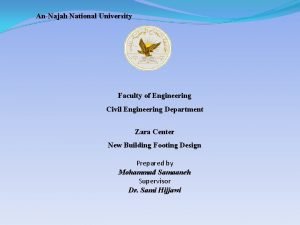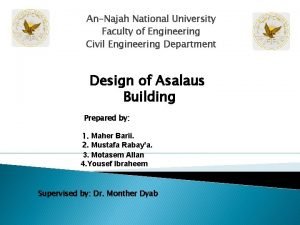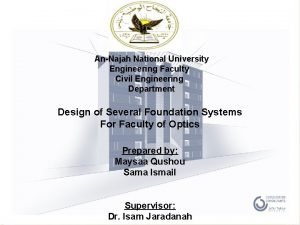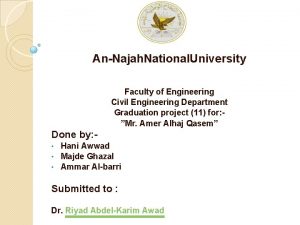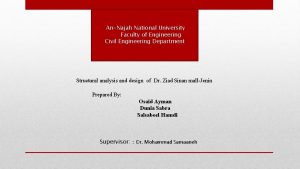AnNajah National University Faculty Of Engineering Civil Engineering





















































- Slides: 53

An-Najah National University Faculty Of Engineering Civil Engineering Department Graduation Project II Analysis and Redesign of Water network & Design of Wastewater network for Kaferdan village Prepared By : Abdallah Bzoor Kefah Ali Mohammed Abo Abed Supervision of Dr. Anan Jayyousi

Outline: Ø Objectives of the project. Ø Significance of the work Ø Study area Ø Questionnaire analysis Ø Existing water network Ø Redesign of water network Ø Design of wastewater network

Objectives Analyze the existing water network. Redesign Design the water network in the village. a wastewater network.

Significance of the work To supply water at an adequate pressure and flow. To transport sewage through KAFERDAN VILLAGE to sewage treatment plants. To have an economic design as possible for both networks.

Study area

v Area and land use: The present population is 6400 persons. The area is approximately 7330 donum Kaferdan village is a flat land, The ground surface in the village varies from 100 m to 190 m (A. M. S. L).

v Data Collection: Contour, Houses, roads, Boundary, aerial photo and amount of consumption water for each consumer, … etc. manhole, conduits, road contour and outfall for the village.

Questionnaire analysis avaerage consumption water Average family size = 5. 9 capita Average consumption = 11. 9 m³ So the water consumption = (11. 9*1000)/(30*5. 9)= 67. 2 L/C/day



Modeling of WDN

Modeling of WDN

WDN

WDN v Design constraints: Pressure at junction between (20 -100) m. H 2 O. Velocity in pipe (0. 3 -3. 0) m/s.

Result of analysis of WDN Preesure at minimum demand (2: 00 am) and maximum demand (6: 00 am)

Result of analysis of WDN Velocities at minimum demand (2: 00 am) and maximum demand(6: 00 am)

Redesign of WDN

Data of future population


Data of future population

Data of the supply

Model of WDN

WDN

Design Critera Type of pipes / Criterea Pressure(m. H 2 O) Velocity(m/sec) Ductile iron 20 -100 0. 1 - 3

Methodology of Design


Result of Design 1 - Pumps

Result of Design Pw = ɤQH Where : ɤ : Specific weight for water(N/ m³). Q : Total flow rate that input to pump (m³/sec). H : Total head that was added by pump (m). Pw = (9810 N/ m³)*(3852/24*60*60 m³/sec)*(20 m) =8747. 25 watt. Pw = 8. 74725 Kelowatt = Poutput. Pinput = Poutput/µ Where : µ : The efficiency of the pump (-) Pinput = 8. 74725/0. 85 = 10. 29 kelowatt. The power of pump (hp) = 10. 29/0. 75 = 14 hp

Result of Design The below drown illustration the method of installation the two pump in series:

Result of Design 2 - Preesures Pressure at maximum demand (6: 00 am) by using of two pumps Pressure at max flow(6: 00 am) 100 90 80 Pressure( m. H 2 O) 70 60 50 40 30 20 0 50 100 150 200 Pipe number 250 300 350 400

Result of Design Pressure at minimum demand (2: 00 am) by using of one pump Pressure at min flow(2: 00 am) 140 120 100 Pressure (m. H 2 O) 80 60 40 20 0 0 -20 50 100 150 200 Pressure number 250 300 350 400

Result of Design 3 - Velovities Velocity at maximum demand (6: 00 am) by using of two pumps Velocity at max flow (6: 00 am) Velocity(m/sec) 2. 55 2. 05 1. 55 1. 05 0. 55 0. 05 0 50 100 150 200 250 Pipe number 300 350 400 450

Cost of The design Total cost = (Ʃ Ci*Li) + Cost of two pumps. Where : Total cost ($). Ci : The cost of diameter i (inch) per meter ($/m). Li : The length of diameter i (m). In this network was the estimated total cost was 303262 $. Cost of one pump (15 hp) = 14000$ The total cost = 303626+28000 = 331626 $

Design of the wastewater network


Wastewater generation Each person in the town will generate about 80% of water consumption(120 L/c/day). Thus , Avaerage wastewater generation = 0. 8 * 120 * 15159/ 1000 = 1455. 26 m³/day Peak wastewater generation = Pf * Avaearage wastewater generation Where : Pf : Peak factor = 16* {(Population in thousands)^(-1/6)} = 16 * (15159)^(-1/6) = 3. 2 Then , Peak wastewater generation for koferdan town = 3 * 1455. 26 = 4365. 75 m³/day

Design criteria The velocity : (0. 6 – 3 m/sec) The cover : (1 -5 m) The slope : (1 -15%) The distance between manholes are (30 -50 m)

Design constrain

MODELING AND DESIGN

Methodology

Methodology Location & Connecting Manhole Before starting the design we should consider that the manholes must be located at the roads networks wherever there is: 1 - An intersection. 2 - Change in slop. 3 - Change in direction. 4 - Maximum distance of (30 -50) m.

Choosing the PVC conduits

Model of the wastewater network

Loads on manholes By finding the area of catchment of each manhole using Arc. Hydro Tool in GIS we can find the load for each manhole as follows: 15159 capita/7328000 m² = 0. 002 capita/ m² 0. 002* area of each part = number of persons in each part(q˳) Load was produced from each part = (120 L/c/d * q˳* 3 * 0. 8) + (120* q˳* 0. 8 * 0. 2)

Results And Discussion

Velocity (m/s)

Slope (%)

Cover (m)

Profile

The proposed location for Wastewater Treatment Plant Location of WWTP

Conclusions After the end of design process we got the following conclusions: The majority diameter of water pipes are 1. 3, 2, 3, 4, 6 and 8 inch. The water pipe material is ductile iron. The sewer conduit material is PVC because it's easy to site. Most sewer network conduits diameters are 8, 10, 12 inch. Arc. Hydro tools save a lot of time in calculates loads.

Recommendations A periodic maintenance should be done and the damaged parts should be replaced. If possible treatment plant is considered as a feasible project. Suitable space between water pipes and wastewater pipes must be achieved (water pipes must be above wastewater pipes).

 National taiwan university civil engineering
National taiwan university civil engineering Faculty of civil engineering ctu prague
Faculty of civil engineering ctu prague Civil engineering faculty
Civil engineering faculty Panti asuhan annajah
Panti asuhan annajah Logo annajah
Logo annajah Annajah motors
Annajah motors Annajah motors
Annajah motors Faculty of engineering university of porto
Faculty of engineering university of porto Lebanese university faculty of engineering
Lebanese university faculty of engineering Clemson university electrical engineering faculty
Clemson university electrical engineering faculty Faculty of mechanical engineering thammasat university
Faculty of mechanical engineering thammasat university Czech technical university in prague civil engineering
Czech technical university in prague civil engineering Civil rights and civil liberties webquest
Civil rights and civil liberties webquest University of split faculty of maritime studies
University of split faculty of maritime studies University of bridgeport engineering
University of bridgeport engineering Bridgeport university computer science
Bridgeport university computer science Hubert kairuki memorial university faculty of medicine
Hubert kairuki memorial university faculty of medicine Hyperparathyreosis
Hyperparathyreosis Applied medical sciences
Applied medical sciences Fsu cybersecurity major
Fsu cybersecurity major Faculty of business and economics mendel university in brno
Faculty of business and economics mendel university in brno Singularity executive program
Singularity executive program Agnes csaki semmelweis
Agnes csaki semmelweis Masaryk university medical faculty
Masaryk university medical faculty Webkredit cuni
Webkredit cuni Faculty of veterinary medicine cairo university logo
Faculty of veterinary medicine cairo university logo Faculty of law of the university of zagreb
Faculty of law of the university of zagreb University of montenegro faculty of law
University of montenegro faculty of law University of kragujevac faculty of technical sciences
University of kragujevac faculty of technical sciences University of cologne faculty of management
University of cologne faculty of management Leading university tuition fees
Leading university tuition fees Hacettepe university faculty of medicine
Hacettepe university faculty of medicine Brown university computer science faculty
Brown university computer science faculty Faculty of veterinary medicine - university of tehran
Faculty of veterinary medicine - university of tehran Semmelweis university faculty of medicine
Semmelweis university faculty of medicine York u myfile
York u myfile Faculty of economics and business debrecen
Faculty of economics and business debrecen Faculty of veterinary medicine cairo university
Faculty of veterinary medicine cairo university Mendel university faculty of business and economics
Mendel university faculty of business and economics Chronic meningitis
Chronic meningitis Mahidol university public health
Mahidol university public health Trypanosoma bruzi
Trypanosoma bruzi Faculty of education khon kaen university
Faculty of education khon kaen university Chulalongkorn university uniform
Chulalongkorn university uniform Cairo university faculty of veterinary medicine
Cairo university faculty of veterinary medicine Lee kong chian faculty of engineering and science
Lee kong chian faculty of engineering and science Faculty of engineering shoubra
Faculty of engineering shoubra Usf canvas
Usf canvas St ann's engineering college chirala faculty
St ann's engineering college chirala faculty Igor dujlovic
Igor dujlovic Hijjawi faculty for engineering technology
Hijjawi faculty for engineering technology Lee kong chian faculty of engineering and science
Lee kong chian faculty of engineering and science Mun engineering complementary studies
Mun engineering complementary studies Studis.fe
Studis.fe





